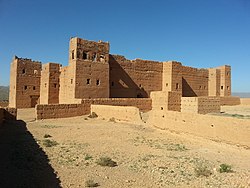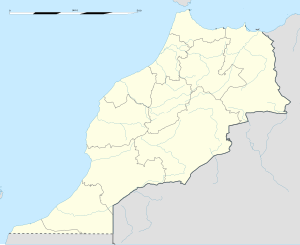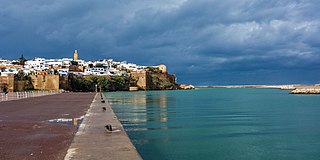
Rabat is the capital city of Morocco and the country's seventh-largest city with an urban population of approximately 580,000 (2014) and a metropolitan population of over 1.2 million. It is also the capital city of the Rabat-Salé-Kénitra administrative region. Rabat is located on the Atlantic Ocean at the mouth of the river Bou Regreg, opposite Salé, the city's main commuter town.

Ouarzazate, nicknamed the door of the desert, is a city and capital of Ouarzazate Province in the region of Drâa-Tafilalet, south-central Morocco.

A kasbah, also spelled qasbah, qasba, qasaba, or casbah, is a fortress, most commonly the citadel or fortified quarter of a city. It is also equivalent to the term alcazaba in Spanish, which is derived from the same Arabic word. By extension, the term can also refer to a medina quarter, particularly in Algeria. In various languages, the Arabic word, or local words borrowed from the Arabic word, can also refer to a settlement, a fort, a watchtower, or a blockhouse.

Nador is a coastal city and provincial capital in the northeastern Rif region of Morocco with a population of about 178,540.

Tadelakt is a waterproof plaster surface used in Moroccan architecture to make baths, sinks, water vessels, interior and exterior walls, ceilings, roofs, and floors. It is made from lime plaster, which is rammed, polished, and treated with soap to make it waterproof and water-repellent. Tadelakt is labour-intensive to install, but durable. Since it is applied as a paste, tadelakt has a soft, undulating character, it can form curves, and it is seamless. Pigment can be added to give it any colour, but deep red is traditional. It may have a shiny or matte finish.

Settat is a city in Morocco between the national capital Rabat and Marrakesh. Settat is located 83.9 km (52.1 mi) by road south of the centre of Casablanca, roughly an hour's drive. It is the capital of Settat Province and is its largest city in both size and population. According to the 2014 Moroccan census, it had a population of 142,250 people, up from 116,570 people in the 2004 census. Settat is 370 m (1,210 ft) above sea level, built on a plateau surrounded by foothills in all directions. The antiquities of Settat include the very old Ismailiya Kasbah distinguished by the statue of a steed which lies at the center of the city.
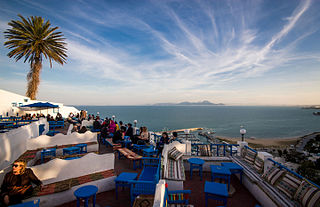
Sidi Bou Said is a town in northern Tunisia located about 20 km northeast from the capital, Tunis.

Qaid, also spelled kaid or caïd, is a word meaning "commander" or "leader." It was a title in the Norman kingdom of Sicily, applied to palatine officials and members of the curia, usually to those who were Muslims or converts to Islam. The word entered the Latin language as gaitus or gaytus. Later the word was used in North Africa for the governor of a fortress or the warden of a prison, also in Spain and Portugal in the form with the definite article "alcayde" or "alcaide". It is also used as a male Arabic given name.

The Kasbah of the Udayas, also spelled Kasbah of the Oudaias or of the Oudayas, is a kasbah (citadel) in Rabat, Morocco. It is located on a hill at the mouth of the Bou Regreg opposite Salé, and adjacent to the Medina quarter of Rabat. It is listed, along with other sites in Rabat, as a UNESCO World Heritage Site.

Aizy-Jouy is a commune in the department of Aisne in the Hauts-de-France region of northern France.

The Kasbah Palace, also known as Dar al-Makhzen, Sultan's Palace or Governor's Palace and formerly as the Sharifian Palace, is a historical building and museum in the Kasbah or citadel of Tangier, Morocco. Its site has long been the main seat of political power in Tangier. The current structure was built in the early 18th century as the residence of the city's governor and home for the Sultan of Morocco when staying in the city, for example Hassan I in 1889. It has been repurposed as a museum since 1922, named the Kasbah Museum of Mediterranean Cultures since renovation in 2016, with the Kasbah Museum Contemporary Art Space added in late 2021.
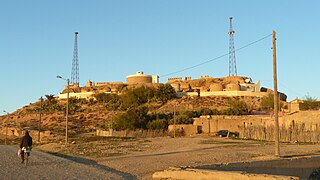
Taourirt is a town in Taourirt Province in the northern part of Morocco. It is located in the Oriental region about 100 km west to the city of Oujda.

Bab Ksiba is a gate in Marrakech, Morocco. Bab Ksiba and another more famous gate further north, Bab Agnaou, served as entrances to the royal Kasbah (citadel) in the southern part of the medina of Marrakech, a UNESCO World Heritage Site.
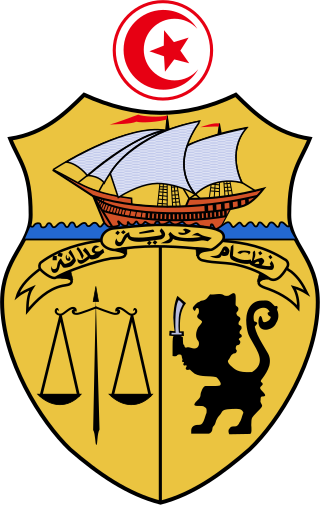
Presidential elections were held in Tunisia on 23 November 2014, a month after parliamentary elections. They were the first free and fair presidential elections since the country gained independence in 1956, and the first direct presidential elections after the Tunisian Revolution of 2011 and the adoption of a new Constitution in January 2014.

In the Democratic Republic of the Congo, chiefdoms and sectors are rural administrative divisions of territories. They are further subdivided into groupings which themselves are divided into villages. Chiefdoms and groupings are led by traditional leaders officially recognized by the government, whereas sector chiefs are appointed directly by the government.
Moha ou Said El Wirrawi was a Moroccan tribal leader who opposed French rule of the protectorate of Morocco. He formerly served as a caïd of the Moroccan sultans and fought for Sultan Abdelaziz against Bou Hmara in 1905. After the Treaty of Fes and the start of the French protectorate he opposed the French through military action. He participated in several battles with French forces in the Zaian War but was eventually forced into the High Atlas mountains where he died in action in 1924. His followers continued to resist the French over the next ten years.

Place Bou Jeloud, also known as Place Pacha el-Baghdadi, is a large public square in Fes, Morocco, located west of Bab Bou Jeloud gate.

The Kasbah of Marrakesh is a large walled district in the southern part of the medina of Marrakesh, Morocco, which historically served as the citadel (kasbah) and royal palace complex of the city. A large part of the district is still occupied by the official royal palace, the Dar al-Makhzen, which serves as the residence of the King of Morocco when he visits the city. The rest of the district consists of various neighbourhoods and monuments. It was founded by the Almohads in the late 12th century, with most of the construction carried out by Caliph Ya'qub al-Mansur. Two of its most important surviving structures today, the Kasbah Mosque and the main gate of Bab Agnaou, date from al-Mansur's reign.

Kasbah Amridil is a historic fortified residence or kasbah in the oasis of Skoura, in Morocco. It is considered among the most impressive kasbahs of its kind in Morocco and was formerly featured on the Moroccan 50 dirham note.

Kasbah Taourirt is a historic fortified residence complex or kasbah in Ouarzazate, Morocco.
